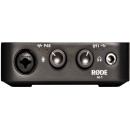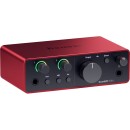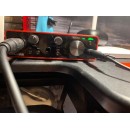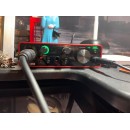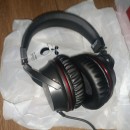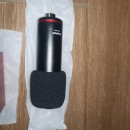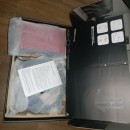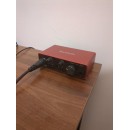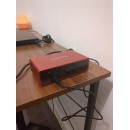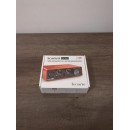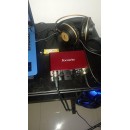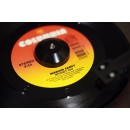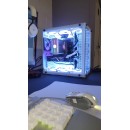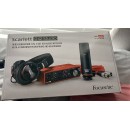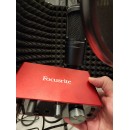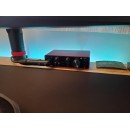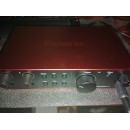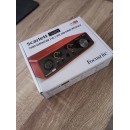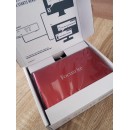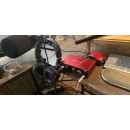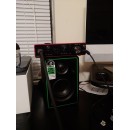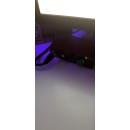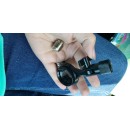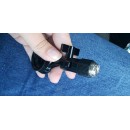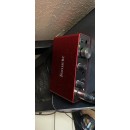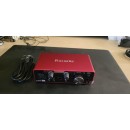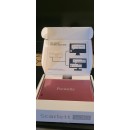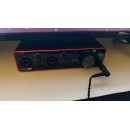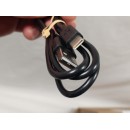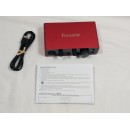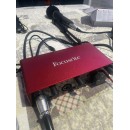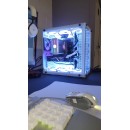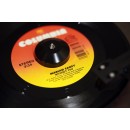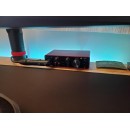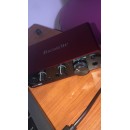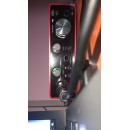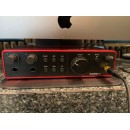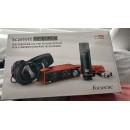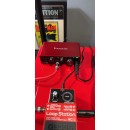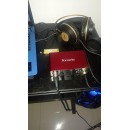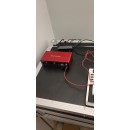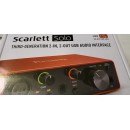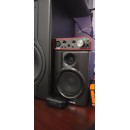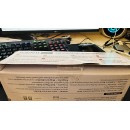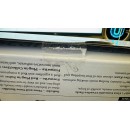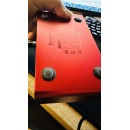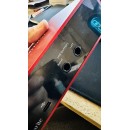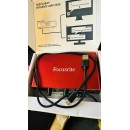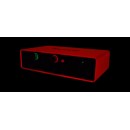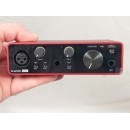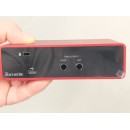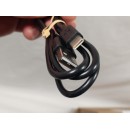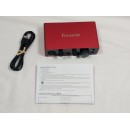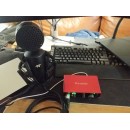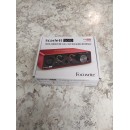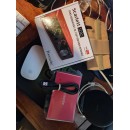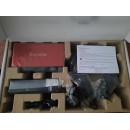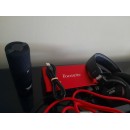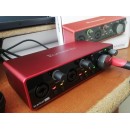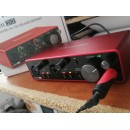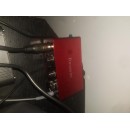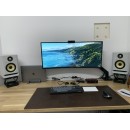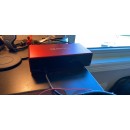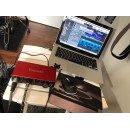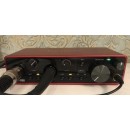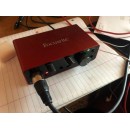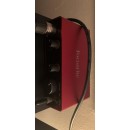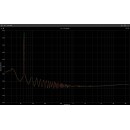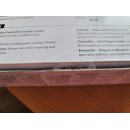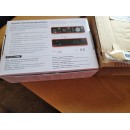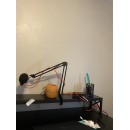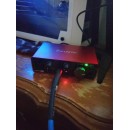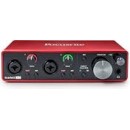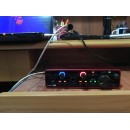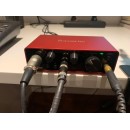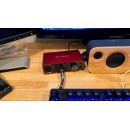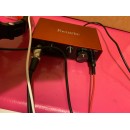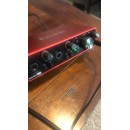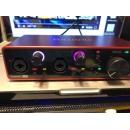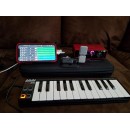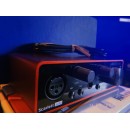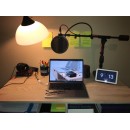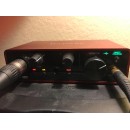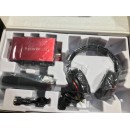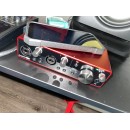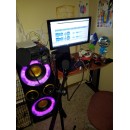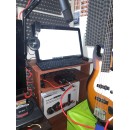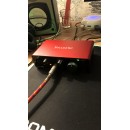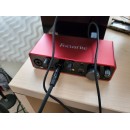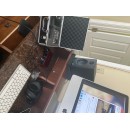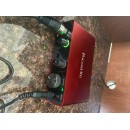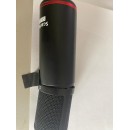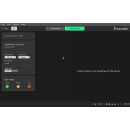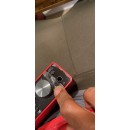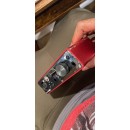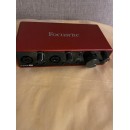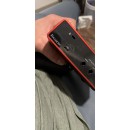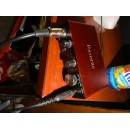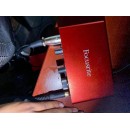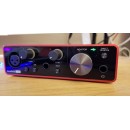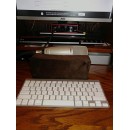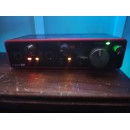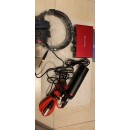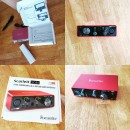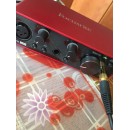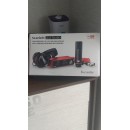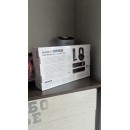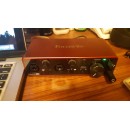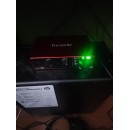RODE AI-1 vs Focusrite Scarlett Solo 4th Gen: In-Depth Comparison
The Focusrite Scarlett Solo (4th Gen) boasts an updated design and improved performance over its predecessors. It features a single upgraded Scarlett mic preamp with switchable Air mode, providing a brighter and more open sound. Additionally, it includes a high-headroom instrument input for guitars and basses, as well as balanced outputs for studio monitors. The 24-bit/192kHz converters ensure pristine audio quality, and the interface is powered via USB-C, making it easy to connect and power through modern computers. The Scarlett Solo also includes a comprehensive software bundle with Ableton Live Lite, Pro Tools First, and various plug-ins, which makes it particularly attractive for beginners and those looking to expand their audio production toolkit.
On the other hand, the RODE AI-1 USB-C Audio Interface is designed with simplicity and ease of use in mind. It features a single Neutrik combo jack input, which accommodates both XLR and 1/4" connections, making it versatile for different types of microphones and instruments. The AI-1 is known for its ultra-low noise and high-gain Revolution Preamp, which ensures clean and detailed recordings. It also offers 24-bit/96kHz audio resolution, which, while slightly lower than the Scarlett Solo, is still highly capable of delivering professional-quality sound. The interface is bus-powered via USB-C and includes a high-quality headphone amplifier for monitoring. The AI-1 is bundled with Ableton Live Lite and a suite of RODE’s own plug-ins, providing a solid start for new users.
In summary, the Focusrite Scarlett Solo (4th Gen) is ideal for users who need a robust software package and slightly higher audio resolution, as well as those who may benefit from the additional Air mode for a more polished sound. The RODE AI-1, with its straightforward design and high-quality preamp, is perfect for users who prioritize simplicity and reliability in a compact form. Both interfaces offer excellent performance and value, making them strong contenders in the entry-level audio interface market.
Specifications, Advantages, and Disadvantages
| User Rating Based on Analysis of Reviews | |
|---|---|
|
Show More |
| Pros: | |
|---|---|
|
|
| Cons: | |
|---|---|
|
|
| Find Best Price | Find Best Price |
| Key Specs | |
|---|---|
| Channels of I/O | |
| 1 Input / 2 Output |
Analog: 2 Inputs / 2 Outputs at 192 kHz |
| Maximum Sampling Rate | |
| 96 kHz / 24-Bit | 192 kHz / 24-Bit |
| Number of Microphone Inputs | |
| 1 | 1 |
| Analog Audio I/O | |
| 1x Combo XLR-1/4" TRS Mic/Line Input 2x 1/4" TRS Balanced Line Output 1x 1/4" TRS Headphone Output |
1x XLR 3-Pin Balanced Mic Input 1x 1/4" TS Unbalanced Line/Hi-Z Input (Front Panel) 2x 1/4" TRS Balanced Monitor Output 1x 1/4" TRS Headphone Output (Front Panel) |
| Digital Audio I/O | |
| Host Connection | |
| USB-C | 1x USB-C |
| OS Compatibility | |
| macOS 10.10 or Later Windows 7 or Later |
macOS Windows |
| Power Requirements | |
| USB Bus Power | USB Bus Power, USB Power Adapter (Not Included) |
In terms of channels of I/O, the Focusrite Scarlett Solo provides 2 analog inputs and 2 analog outputs at a maximum sampling rate of 192 kHz / 24-bit. In comparison, the RODE AI-1 offers 1 input and 2 output channels with a maximum sampling rate of 96 kHz / 24-bit. This suggests that the Focusrite Scarlett Solo offers higher audio fidelity with its 192 kHz sampling rate.
Both interfaces feature 1 microphone input. The Focusrite Scarlett Solo includes 1 XLR 3-Pin Balanced Mic Input, while the RODE AI-1 offers a combo XLR-1/4" TRS Mic/Line Input. This combo input on the RODE AI-1 provides versatility for either microphone or line-level input through the same connection.
Regarding analog audio I/O, the Focusrite Scarlett Solo includes 1 XLR mic input, 1 1/4" TS unbalanced line/Hi-Z input on the front panel, 2 1/4" TRS balanced monitor outputs, and 1 1/4" TRS headphone output on the front panel. On the other hand, the RODE AI-1 features 1 combo XLR-1/4" TRS mic/line input, 2 1/4" TRS balanced line outputs, and 1 1/4" TRS headphone output. This means the Focusrite Scarlett Solo offers a separate Hi-Z input for instruments, which the RODE AI-1 does not.
Neither of the interfaces includes digital audio I/O, and both connect to the host via USB-C. Regarding OS compatibility, both interfaces are compatible with macOS and Windows, with the RODE AI-1 supporting macOS 10.10 or later and Windows 7 or later, while the Focusrite Scarlett Solo supports macOS and Windows without specifying versions.
For power requirements, both interfaces are powered via USB bus power, with the Focusrite Scarlett Solo also allowing for an optional USB power adapter (not included). The RODE AI-1 relies solely on USB bus power.
In summary, while both interfaces offer robust features for a range of audio recording needs, the Focusrite Scarlett Solo stands out with its higher sampling rate and additional Hi-Z input, offering slightly more versatility for users.
| General | |
|---|---|
| Channels of I/O | |
| 1 Input / 2 Output |
Analog: 2 Inputs / 2 Outputs at 192 kHz |
| Built-In DSP | |
| Maximum Sampling Rate | |
| 96 kHz / 24-Bit | 192 kHz / 24-Bit |
| Number of Microphone Inputs | |
| 1 | 1 |
| Built-In Microphone | |
| Input Level Adjustment | |
| 2x Knob | 2x Knob |
| Expansion Slots | |
The Focusrite Scarlett Solo provides 2 channels of analog I/O at a maximum sampling rate of 192 kHz with 24-bit resolution. It features 1 microphone input and does not include built-in DSP or a built-in microphone. The device allows for input level adjustment through 2 knobs and does not offer expansion slots for additional connectivity or functionality.
On the other hand, the RODE AI-1 USB-C Audio Interface offers 1 analog input and 2 outputs at a maximum sampling rate of 96 kHz with 24-bit resolution. Similar to the Scarlett Solo, it includes 1 microphone input, lacks built-in DSP, and does not feature a built-in microphone. Input level adjustment is also managed through 2 knobs, and there are no expansion slots available for further expansion.
In summary, the Focusrite Scarlett Solo stands out with its higher maximum sampling rate of 192 kHz, providing more detailed audio capture, and offers an additional input channel compared to the RODE AI-1. Both devices share similar features in terms of input level adjustment and the absence of built-in DSP or microphones, making them suitable for users seeking straightforward and effective audio interfaces without additional processing capabilities.
| Signal Processing | |
|---|---|
| Gain/Trim Range | |
| Inputs: 0 to 45 dB |
Mic/Line Inputs: Up to +69 dB Hi-Z Inputs: 62 dB |
The Focusrite Scarlett Solo (4th Generation) offers a more extensive gain/trim range, providing up to +69 dB for mic/line inputs and 62 dB for Hi-Z inputs. This wide range of gain/trim makes the Scarlett Solo versatile for a variety of microphones and instruments, accommodating both low-sensitivity mics and high-output instruments effectively. This can be particularly beneficial for users who need flexibility in handling different audio sources without requiring additional preamps.
On the other hand, the RODE AI-1 USB-C Audio Interface presents a more limited gain/trim range, with inputs ranging from 0 to 45 dB. While this may suffice for many standard recording situations, it may not offer the same level of adaptability for lower-output microphones or high-gain instruments as the Scarlett Solo. This narrower gain range could necessitate additional equipment to achieve optimal levels for certain recording scenarios.
Additionally, the RODE AI-1 lacks features such as a high-pass filter and solo/mute options, which are often useful for refining the audio signal and managing monitoring setups during recording and production. The absence of these features means that users may need to rely on external software or hardware to perform these functions, potentially complicating the recording process.
In summary, the Focusrite Scarlett Solo (4th Generation) stands out with its broader gain/trim range and flexibility, making it a more versatile choice for a variety of recording needs. The RODE AI-1, while a solid interface, offers a more limited gain range and lacks additional features like high-pass filtering and solo/mute options, which could be important for some users.
| Connectivity | |
|---|---|
| Analog Audio I/O | |
| 1x Combo XLR-1/4" TRS Mic/Line Input 2x 1/4" TRS Balanced Line Output 1x 1/4" TRS Headphone Output |
1x XLR 3-Pin Balanced Mic Input 1x 1/4" TS Unbalanced Line/Hi-Z Input (Front Panel) 2x 1/4" TRS Balanced Monitor Output 1x 1/4" TRS Headphone Output (Front Panel) |
| Phantom Power | |
| 48 V | 48 V, Selectable On/Off |
| Digital Audio I/O | |
| Host Connection | |
| USB-C | 1x USB-C |
| Host Connection Protocol | |
| Not Specified by Manufacturer | USB 2.0 |
| USB (Non-Host) | |
| Sync I/O | |
| Network I/O | |
| MIDI I/O | |
In terms of analog audio I/O, the Focusrite Scarlett Solo provides a 1x XLR 3-pin balanced mic input and a 1x 1/4" TS unbalanced line/Hi-Z input on the front panel. It also includes 2x 1/4" TRS balanced monitor outputs and a 1x 1/4" TRS headphone output on the front panel. This setup is designed to cater to both vocal recording through the XLR input and instrument recording through the Hi-Z input, offering flexibility for different recording scenarios.
On the other hand, the RODE AI-1 offers a slightly different configuration. It includes a 1x combo XLR-1/4" TRS mic/line input, which supports both microphone and line-level signals in a single input. Additionally, it has 2x 1/4" TRS balanced line outputs and a 1x 1/4" TRS headphone output. The combo input on the RODE AI-1 simplifies connectivity by allowing users to plug in either an XLR or a 1/4" TRS connector into the same port.
Both interfaces provide 48V phantom power, which is essential for using condenser microphones. This feature is selectable on the Focusrite Scarlett Solo, allowing users to turn it on or off as needed.
Regarding the host connection, both devices use USB-C, ensuring fast and reliable data transfer to the host computer. The Focusrite Scarlett Solo specifies its host connection protocol as USB 2.0, while the RODE AI-1 does not specify the protocol, which may suggest a focus on ease of use rather than technical specifics.
Neither of the interfaces includes digital audio I/O, USB (non-host), Sync I/O, Network I/O, MIDI I/O, or wireless capabilities. This indicates that both interfaces are streamlined for straightforward audio recording and playback without additional digital connectivity or synchronization features.
In summary, the Focusrite Scarlett Solo and the RODE AI-1 both offer essential features for high-quality audio recording through USB-C connectivity. The Scarlett Solo stands out with its dedicated mic and instrument inputs, while the RODE AI-1 offers a versatile combo input. Both provide balanced monitor outputs and headphone outputs, ensuring they can handle professional monitoring needs.
| Performance | |
|---|---|
| Frequency Response | |
| 20 Hz to 20 kHz ±1 dB |
XLR Mic Inputs: 20 Hz to 20 kHz ±0.06 dB 1/4" Line Inputs: 20 Hz to 20 kHz 0.05 dB 1/4" Hi-Z Inputs: 20 Hz to 20 kHz 0.15 dB |
| Maximum Output Level | |
| Monitor Outputs: -6 dBu |
1/4" Line: +16 dBu |
| Headphone Output Power | |
| 24 mW into 32 Ohms 245 mW into 300 Ohms |
1/4": 32 mW into 33 Ohms 22 mW into 300 Ohms |
| Impedance | |
| Hi-Z Inputs: 0.9 Megohm Mic Inputs: 1.3 Kilohms |
XLR Mic Inputs: 3 Kilohms 1/4" Line Inputs: 60 Kilohms 1/4" Hi-Z Inputs: 1 Megohms 1/4" Line Outputs: 200 Ohms 1/4" Headphone Outputs: < 50 Ohm |
| Dynamic Range | |
| 104 dBu |
XLR Mic Inputs: 113 dBA 1/4" Line Inputs: 113 dBA 1/4" Hi-Z Inputs: 112 dBA 1/4" Line Outputs: 120 dB 1/4" Headphone: 112 dB (at 33 Ohms) 115 dB (at 300 Ohms) Digital A/D Converters: 120 dB Digital D/A Converters: 130 dBA |
| EIN | |
| -128 dBA |
XLR Mic Inputs: -127 dBu A-Weighted |
In terms of frequency response, the Focusrite Scarlett Solo offers a slightly tighter range with its XLR mic inputs (20 Hz to 20 kHz ±0.06 dB), 1/4" line inputs (20 Hz to 20 kHz ±0.05 dB), and 1/4" Hi-Z inputs (20 Hz to 20 kHz ±0.15 dB) compared to the RODE AI-1, which has a frequency response of 20 Hz to 20 kHz ±1 dB. This indicates that the Scarlett Solo might provide a more precise and accurate reproduction of sound across the audible spectrum.
When looking at maximum input and output levels, the Scarlett Solo supports a maximum input level of 9.5 dBu for XLR mic, 22 dBu for 1/4" line, and 12 dBu for 1/4" Hi-Z inputs. Its maximum output level for the 1/4" line is +16 dBu. In contrast, the RODE AI-1 has a maximum output level for monitor outputs of -6 dBu. This suggests that the Scarlett Solo can handle and output higher signal levels, which can be beneficial for various professional audio applications.
The headphone output power also differs significantly between the two. The Scarlett Solo provides 32 mW into 33 Ohms and 22 mW into 300 Ohms, while the RODE AI-1 offers 24 mW into 32 Ohms and a notably higher 245 mW into 300 Ohms. This makes the RODE AI-1 potentially more powerful for driving high-impedance headphones, which could be a critical factor for users requiring strong headphone output.
Regarding impedance, the Scarlett Solo has XLR mic inputs with 3 Kilohms, 1/4" line inputs with 60 Kilohms, 1/4" Hi-Z inputs with 1 Megohm, and 1/4" line outputs with 200 Ohms. The RODE AI-1, on the other hand, offers Hi-Z inputs with 0.9 Megohm and mic inputs with 1.3 Kilohms. This indicates that both interfaces are capable of handling various input sources, but the Scarlett Solo provides higher impedance options, which may affect compatibility with different microphones and instruments.
In terms of dynamic range, the Scarlett Solo excels with values such as 113 dBA for XLR mic inputs, 113 dBA for 1/4" line inputs, 112 dBA for 1/4" Hi-Z inputs, 120 dB for 1/4" line outputs, and up to 115 dB for headphone outputs at 300 Ohms. The RODE AI-1, however, has a dynamic range of 104 dBu, which is lower in comparison. This means the Scarlett Solo can capture and output a wider range of sound levels, from the quietest to the loudest, with greater detail.
Lastly, the EIN (Equivalent Input Noise) for both interfaces is quite close, with the Scarlett Solo at -127 dBu A-Weighted and the RODE AI-1 at -128 dBA. This means both interfaces offer low noise levels, ensuring clean audio recordings.
In summary, the Focusrite Scarlett Solo USB-C Audio Interface (4th Generation) generally offers superior technical specifications in terms of frequency response, maximum input and output levels, dynamic range, and a broader range of impedance options. The RODE AI-1, however, excels in headphone output power, making it more suitable for users requiring high headphone amplification.
| Digital Audio | |
|---|---|
| Sample Rates | |
| 44.1 / 48 / 88.2 / 96 kHz | 44.1 / 48 / 88.2 / 96 / 176.4 / 192 kHz |
| Bit Depths | |
| 24-Bit | 24-Bit |
The Focusrite Scarlett Solo USB-C Audio Interface (4th Generation) supports a wider range of sample rates, including 44.1, 48, 88.2, 96, 176.4, and 192 kHz. This broad range makes it versatile for various audio production needs, from basic recordings to high-resolution audio projects. It maintains a 24-bit depth, which is standard for professional-grade audio interfaces, ensuring high-quality sound reproduction. The Scarlett Solo relies on internal sync sources for its clocking.
In contrast, the RODE AI-1 USB-C Audio Interface supports sample rates of 44.1, 48, 88.2, and 96 kHz, which, while sufficient for most recording applications, does not reach the higher sample rates available on the Scarlett Solo. Like the Scarlett Solo, it also operates at a 24-bit depth, providing professional audio quality. The RODE AI-1 includes zero-latency direct monitoring, a feature that allows real-time audio monitoring without any noticeable delay, which can be crucial for live recording situations. It also uses internal clocking for synchronization.
In summary, while both interfaces offer high-quality audio with 24-bit depth, the Focusrite Scarlett Solo provides a broader range of sample rates, making it more versatile for high-resolution audio work. The RODE AI-1, however, offers zero-latency direct monitoring, which is beneficial for real-time recording scenarios. Both interfaces are well-suited for different needs, with the Scarlett Solo being ideal for varied and high-resolution projects, and the RODE AI-1 excelling in live monitoring and straightforward recording setups.
| Compatibility | |
|---|---|
| OS Compatibility | |
| macOS 10.10 or Later Windows 7 or Later |
macOS Windows |
In contrast, the RODE AI-1 USB-C Audio Interface also supports both macOS and Windows operating systems but with slightly different version requirements. It is compatible with macOS 10.10 or later and Windows 7 or later, which covers a range of older and newer systems. However, the RODE AI-1 does not advertise compatibility with any mobile operating systems, which might limit its use for users looking to integrate their audio interface with mobile devices like iPads.
Both interfaces provide robust solutions for home studios and portable recording setups, but the Focusrite Scarlett Solo’s additional mobile app compatibility for iPadOS could be a significant advantage for users who require or prefer mobile recording capabilities.
| Power | |
|---|---|
| Power Requirements | |
| USB Bus Power | USB Bus Power, USB Power Adapter (Not Included) |
In terms of power consumption, the Focusrite Scarlett Solo consumes 4.5 watts. This specification is not explicitly stated for the RODE AI-1, making it difficult to directly compare the two in this regard. The lack of detailed power consumption information for the RODE AI-1 may imply that it is optimized to run efficiently solely on USB bus power without the need for additional power adapters.
Overall, both interfaces are designed to be portable and easy to use with USB-C connectivity, but the Focusrite Scarlett Solo offers a bit more flexibility in power options, which could be a deciding factor for users with specific power requirements.
| Physical | |
|---|---|
| Dimensions | |
| 4.9 x 3.9 x 1.5" / 124 x 100 x 38 mm | 5.63 x 3.78 x 1.79" / 14.3 x 9.6 x 4.55 cm |
| Weight | |
| 19.8 oz / 561.3 g | 0.8 lb / 363.0 g |
In terms of dimensions, the Focusrite Scarlett Solo measures 5.63 x 3.78 x 1.79 inches (14.3 x 9.6 x 4.55 cm), making it slightly larger than the RODE AI-1, which measures 4.9 x 3.9 x 1.5 inches (124 x 100 x 38 mm). Despite the difference in size, both interfaces are designed to be easily portable and suitable for a range of recording environments.
When it comes to weight, the Focusrite Scarlett Solo is significantly lighter at 0.8 lb (363.0 g) compared to the RODE AI-1, which weighs 19.8 oz (561.3 g). This makes the Scarlett Solo a more lightweight option, potentially offering greater convenience for users who need to transport their audio interface frequently.
Both interfaces utilize USB-C connectivity, ensuring modern and efficient data transfer. The choice between these two might come down to the importance of portability and weight versus the specific feature set and sound characteristics each brand offers.
| Packaging Info | |
|---|---|
| Package Weight | |
| 1.155 lb | 1.305 lb |
| Box Dimensions (LxWxH) | |
| 7 x 5.1 x 2.55" | 7.2 x 6.1 x 2.5" |
Starting with the package weight, the Focusrite Scarlett Solo weighs 1.305 lb, making it slightly heavier than the RODE AI-1, which has a package weight of 1.155 lb. This difference in weight might be a consideration for users who prioritize portability, as the RODE AI-1 is marginally lighter.
In terms of box dimensions, the Focusrite Scarlett Solo measures 7.2 x 6.1 x 2.5 inches (LxWxH). On the other hand, the RODE AI-1 is slightly more compact with dimensions of 7 x 5.1 x 2.55 inches (LxWxH). This makes the RODE AI-1 not only lighter but also smaller in width and length, which could be advantageous for users with limited space or those who prefer a more compact setup.
Overall, both audio interfaces offer robust features for audio recording and streaming, but the Focusrite Scarlett Solo is slightly heavier and larger in box dimensions compared to the more compact and lighter RODE AI-1.
| Customer Images | |
|---|---|
| Videos | |
|---|---|
|
|
|
